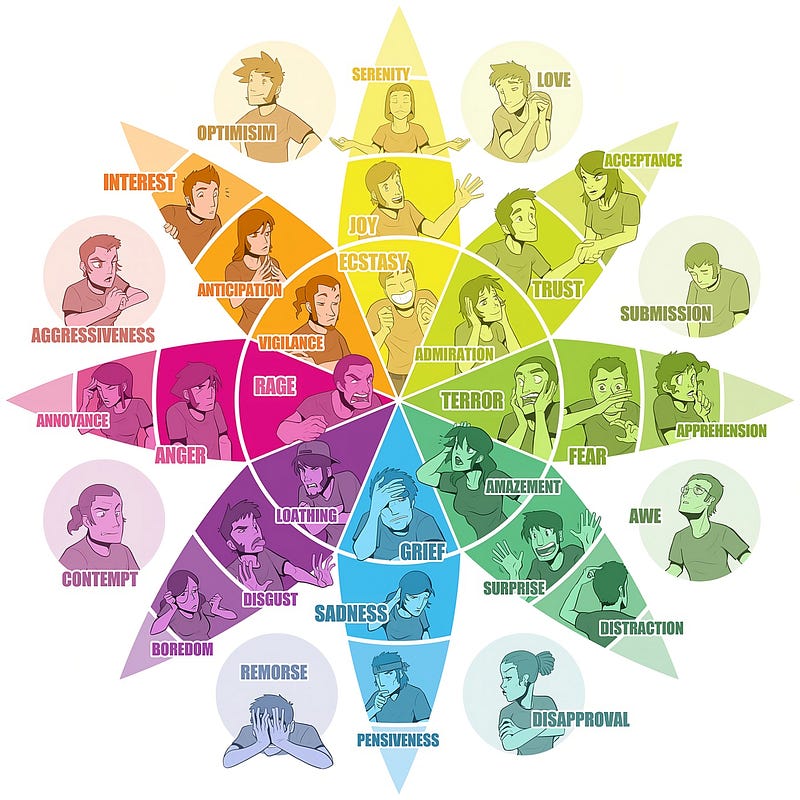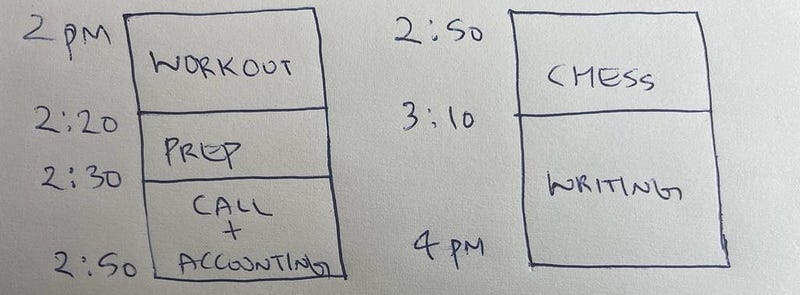# Achieve in 2 Hours What Others Take a Full Day To Do
Written on
Maximizing Productivity in Just Two Hours
In just two hours, I managed to fit in a challenging workout, a work meeting, my monthly financial review, and even a couple of quick chess matches—along with drafting this article. This encapsulates an incredibly productive day within a brief timeframe.
While we occasionally experience these bursts of exceptional productivity, replicating them can be a challenge. By reflecting on such moments, I've identified a consistent pattern that I will outline in a four-step framework that you can apply.
Step 0: Establish a “Snap” Trigger
Imagine a scenario where you’re forced to perform 50 push-ups to gain your freedom. Without hesitation, you would immediately rise to the challenge. This is what I refer to as a “snap” trigger—a powerful motivator that compels you to act.
Such triggers eliminate trivial distractions and concentrate your attention into a focused beam. For me, the disappointment of breaking a long streak in self-control ignited a strong emotional response that propelled me into action.
Powerful emotions—whether positive or negative—can serve as effective snap triggers.

While we may consider ourselves rational beings, our decisions are often driven by emotions, much like our ancestors. However, depending solely on external situations for motivation can be unreliable.
Fortunately, you can create your own snap triggers through self-reflection and creativity:
- Turn negatives into positives: Use any setbacks as motivation to engage in a beneficial activity.
- Set artificial deadlines and establish accountability, such as planning a workout with a friend.
- Compile inspiring videos, quotes, or book summaries for easy access.
- Keep a journal to clarify your priorities and tasks.
- Ask yourself probing questions: “Am I feeling stuck?”, “What’s holding me back?”, “What do I envision for the next year?”
- Listen to energizing music to help enter a focused state.
As Nietzsche said, “He who has a why to live for can bear almost any how.” Find your “why,” and it will drive you to focus.
Step 1: Eliminate Distractions
A single notification can derail your concentration, with research indicating that it may take up to 23 minutes to regain focus after an interruption. To safeguard your productivity, consider these steps:
- Turn off all notifications and switch your phone to airplane mode.
- Find a quiet workspace and wear headphones to signal focused time.
- Organize your workspace and digital environment, retaining only what’s essential.
- Use gray-scale mode on your devices unless color is necessary for your work.
- Block distracting websites and applications with tools like ColdTurkey.
- Keep your phone out of sight and within a distance that minimizes temptation.
- Ensure you have water nearby to stay hydrated and avoid breaks for gossip.
Investing just 15 minutes to reduce distractions can save you countless hours.
Step 2: Focus Like a Sniper
Think back to gaming in college where we would spray our shots haphazardly, hoping to hit something. The best players, however, were methodical, picking off targets with precision.
In productivity, your focus is your ammunition. You can either scatter your attention across multiple tasks or concentrate on one at a time to accomplish more.

Avoid the “spray and pray” approach. Instead:
- Select two deep tasks (like writing or studying) and two shallow ones (like responding to emails).
- Clearly define each task, e.g., “Draft a 4-minute article on maximizing productivity” instead of “Work on an article.”
- Prioritize these tasks and include preparatory work to streamline the actual tasks.
When you aim and execute with precision, your productivity will soar.
Step 3: The Importance of Preparation
As Napoleon Hill famously stated, “Whatever the mind can conceive and believe, the mind can achieve.” To prepare for your two-hour productivity sprint, visualize the tasks ahead. For instance, my plan includes:
- A 20-minute intense workout.
- Ten minutes to outline this article and prepare for a work call.
- A 20-minute call, during which I also manage my financial review.
- Twenty minutes for chess to keep my mind sharp.
- Finally, spend 50 minutes drafting this article.
While reality may vary, visualization acts as a mental anchor, making the subsequent steps easier:
- Alternate between deep and shallow tasks to allow your mind to recharge.
- Schedule these tasks on paper and mentally rehearse your workflow.

Step 4: Adopt a HIIT Work Style
High-Intensity Interval Training (HIIT) alternates between intense activity and rest, yielding greater results in less time compared to Low-Intensity Steady State (LISS) exercises.
Similarly, a couple of focused hours of work can surpass an entire day of fragmented efforts. As Naval Ravikant notes, “Forty-hour workweeks are a relic of the Industrial Age. Knowledge workers function like athletes—train, sprint, then rest and reassess.”
The Pomodoro Technique is a useful starting point—25 minutes of work followed by 5 minutes of rest. For an added twist, try the “musical Pomodoro” with a playlist that matches your work duration.

Putting Your Plan into Action
To summarize, here’s how to maximize your productivity in a two-hour window:
- Identify a compelling “snap” trigger that propels you into action.
- Eliminate distractions—set your phone to DND, declutter your workspace, and use blockers.
- Choose four specific tasks—two deep and two shallow—and prioritize them.
- Alternate between deep and shallow tasks, timebox them, and visualize the entire process.
- Work in focused sprints, taking brief breaks in between.
At the core of this blueprint is the understanding that more time doesn’t equate to better results. By focusing on shorter, intense bursts of work, you can produce higher quality and quantity in less time. Make your next two hours count!
Want to Supercharge Your Productivity? Download the Free 2-Minute Journaling Template.
2 ChatGPT (Free) Chrome Extensions So Useful They Almost Feel Illegal
- Save hours on writing emails, googling, learning, and more.
9 Innovative 2-Minute Habits to Save (at Least) 20 Hours a Week
- Science-backed techniques you may not have encountered before.